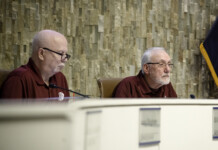
The city may not be able to predict how much rain will fall, but it has a plan in place for when heavy rainfall causes flooding like Wednesday’s.
Flooding isn’t new to Maricopa, as Brent Billingsley, the city’s director for development services, pointed out.
“We’ve been through a bunch of these,” Billingsley said, referring to the city’s public works, fire, police and other city departments.
Rain, which fell for five hours Tuesday night, breached a drainage channel north and east of Tortosa, Billingsley said.
That water, runoff from the Sacaton Mountains, flowed into the northeast section of the Tortosa subdivision near Dalli Lane and Madrid Avenue.
Operating in the area is a Global Water wastewater collection lift station, which is a kind of underground basin holding waste from 150 homes before forwarding it on to a larger treatment facility, said Ron Fleming, general manager of Global Water’s regulated utilities in Arizona.
“There was so much rainwater that it fully submerged our infrastructure,” Fleming said.
Sewage was lifted above ground from the underwater basin and mixed with rain water.
Even though the waste was “almost completely diluted” by rainwater, and there was no public safety hazard, he said, it compounded the flooding issue.
Billingsley said whenever there’s rainfall in the area, the public works crews have set procedures to activate.
“It’s kind of like how the fire department or the police department would respond (to a situation),” Billingsley said.
The first step is for crews to go out and check arterial roads for standing water.
“We know every inch of road in Maricopa, every piece of it and every nook, so we know where to look,” Billingsley said.
Then, where necessary, crews put up signs for motorists and put up some of the smaller pumps – with 3-inch pipes and an engine comparable to a lawnmower’s – to get the water off of the roadway.
“In most cases, it’s not a life-threatening situation,” Billingsley said.
Wednesday’s event, though nonlife-threatening, wasn’t routine.
“It’s clear that there are damages and expenditures that are outside the norm,” he said.
That’s why, after consulting with city administrators, Mayor Christian Price declared a state of emergency Wednesday.
This, Price said Thursday, “is not a reason for everyone to go running around with their hair on fire.”
“All you’re doing is freeing up finances and resources,” he said. “And they’re very temporary. Once the need is gone, they’re rescinded.”
The declaration allowed the city to temporarily bypass strict funding approval measures and hire a contractor who brought in two dump trucks, an excavator and similar heavy-duty equipment.
“We need 100 tons of material to fix that (drainage channel),” Price said.
By 7 a.m. Wednesday, the public works crew was out assessing damage and figuring out just what, exactly, had happened.
“It took us a while to figure out why the water was there and where it was coming from,” Billingsley said.
The crew noticed water – a lot of standing water – was getting close to homes and nearby retention basins were at capacity.
The priority at that point, Billingsley said, was to get the water out of the area and decrease the water level in the retention basin.
Also, the sewage issue had to be addressed, residents of the area needed to be safe, property needed to be protected and traffic needed to be re-routed.


![State: Pinal County fire activity concerning Tucson's Northwest Fire District crew members assist in firefighting efforts on the "Flying Bucket Fire" approximately 15 miles southwest of Maricopa on May 8, 2024. [Northwest Fire District]](https://www.inmaricopa.com/wp-content/uploads/2024/05/GNEq06pbwAA6JlT-218x150.jpg)



![Carl’s Jr plans to “open soon” An exterior view of the new Carl's Jr. restaurant along John Wayne Parkway on May 7, 2024. [Elias Weiss]](https://www.inmaricopa.com/wp-content/uploads/2024/05/E1C66482-CB4C-4FD0-BA30-35CECE93F4BE-218x150.jpeg)
![Filiberto’s eyes building Maricopa restaurant An exterior view of a Filiberto's Mexican Food restaurant at an unknown location and date. [Jessica Boehm/Axios]](https://www.inmaricopa.com/wp-content/uploads/2024/05/axios-050724-filibertos-screenshot-e1715117410101-218x150.jpg)
![SR 238 closures start tomorrow SR 238 [File]](https://www.inmaricopa.com/wp-content/uploads/2022/04/az-238_e_seq_034-218x150.jpg)


![Traffic change to reduce backup at Villages intersection The intersection at Butterfield Parkway and West Edison Road on May 10, 2024. [Brian Petersheim Jr.]](https://www.inmaricopa.com/wp-content/uploads/2024/05/PJ_5644-218x150.jpg)
![Gila River Bridge construction to begin Monday A screenshot showing an aerial view of the current Gila River bridges on Interstate 10 on an unknown date. [Arizona Department of Transportation]](https://www.inmaricopa.com/wp-content/uploads/2024/05/Screenshot-2024-05-10-154035-218x150.png)

![Southern soul on the spread at new food truck Owners Lakeesha Akins, Bridget Akins and Corey Jacobs stand in front of the Sunday's Soul Food truck at the Central Arizona College Maricopa campus on May 14, 2024. [Monica D. Spencer]](https://www.inmaricopa.com/wp-content/uploads/2024/05/spencer-051424-sundays-soul-food-grand-opening-web-01-100x70.jpg)


